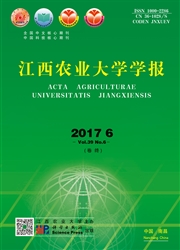

 中文摘要:
中文摘要:
为筛选出特异性高的红唇薄鳅微卫星位点,采用生物素探针(AC)13杂交和FIASCO磁珠富集法从红唇薄鳅基因组DNA中分离出一批微卫星序列,并对其序列特征进行分析。结果显示,157个单克隆中,阳性克隆为131个,阳性克隆率为83.44%。排除重复序列后,共得到69条重复类型和重复次数不同微卫星序列,阳性富集率为52.67%。在这些微卫星序列中,共检测到110个微卫星位点,其中90个二碱基重复微卫星位点,14个四碱基重复微卫星位点,6个五碱基重复微卫星位点。二碱基重复中,以AC/TG重复最为丰富(73个位点),四碱基重复中,AAAG重复数目最多(6个位点),只发现了1种五碱基重复TCTTC(6个位点)。微卫星重复次数在6-10次之间最多(65.45%),20次以上的较少(0.91%)。二碱基重复微卫星的变异系数最大(36.52%),四碱基重复类型的变异系数最小(26.75%)。红唇薄鳅微卫星以完美型为主(63.64%),复合型次之(23.63%),非完美型最少(12.73%)。筛选出的这些微卫星位点将对红唇薄鳅及近缘种微卫星分子标记开发和应用提供依据。
 英文摘要:
英文摘要:
In order to isolate high specific microsatellite markers for Leptobotia rubrilaris,biotin probe( AC)13hybridization and magnetic bead enrichment were used to separate a set of microsatellite sequences,and the sequence characteristics.The results showed that 131 clones were positive in 157 monoclones,the rate of positive clones was 83.44%.Discharging the same repeats,69 sequences of different repeat types and different repetitions were obtained,the rate of positive enrichment was 52.67%.The total number of microsatellites was 110 loci,including 90 di - nucleotide repeat loci,14 tetra-nucleotide repeat loci and 6 penta-nucleotide repeat loci.AC / TG repeat type was the most abundant in the di-nucleotide repeat microsatellites( 73 loci),AAAG repeat type was the most abundant in tetra-nucleotide repeat microsatellite( 6 loci),only one penta-nucleotide repeat microsatellite type,TCTTC,was found in these microsatellite loci( 6 loci).Most of the microsatellite( 65.45%)repeated from 6 to 10 times,the loci which repeated more than 20 times were the least( 0.91%).The variation coefficient of di-nucleotide repeat microsatellites was the largest( 36.52%),while the value of tetra-nucleotide repeat microsatellite was the smallest( 26. 75%). The percentage of perfect microsatellites was 63. 64%,the percentage of mixed type was 23.63% and the percentage of non-perfect microsatellites was 12.73%.These microsatellite loci will provide scientific basis for the development and utilization microsatellite markers of Leptobotia rubrilaris and related species.
 同期刊论文项目
同期刊论文项目
 同项目期刊论文
同项目期刊论文
 期刊信息
期刊信息
